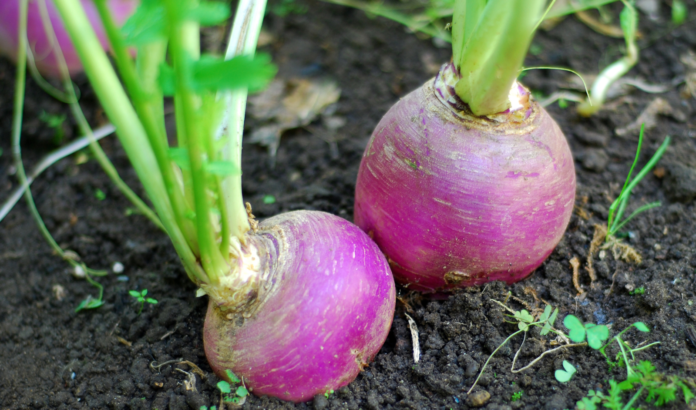Turnips are root vegetables from the Brassicaceae family, which also includes broccoli, kale, and cabbage. They are scientifically classified as Brassica rapa and are believed to have originated in Central and Eastern Asia thousands of years ago. Their cultivation has spread worldwide due to their versatility, nutritional value, and ability to thrive in cool climates.
Key Characteristics:
- Appearance: Turnips typically have a round or slightly oval shape with smooth, firm skin. They are usually white at the base with a purple, red, or greenish top, depending on exposure to sunlight. Some varieties are all-white or golden.
- Edible Parts: Both the root and the leafy greens of the turnip are edible. The root has a mildly sweet and peppery flavor, while the greens are more bitter and robust.
- Size: Smaller turnips are tender and sweet, while larger ones can be starchier and more fibrous.
Interesting Facts About Turnips:
- Ancient Origins: Turnips (Brassica rapa) are believed to have originated over 4,000 years ago in Central Asia, making them one of the oldest cultivated vegetables. Ancient civilizations, including the Romans and Greeks, considered them a staple food
- Record: The world record for the largest turnip is a massive 63.9 pounds, set in 2020. This record highlights the incredible growth potential of this often-overlooked vegetable.
- Historical Accident: In Ancient Rome, turnips were used as projectiles to pelt disliked public figures, making them an unconventional weapon for expressing displeasure. Additionally, in the 15th century, “turnip eater” was a common insult.
- Jack-o’-Lantern Origins: Turnips, not pumpkins, were the original vegetables used for carving Jack-o’-lanterns, especially in Irish folklore. This tradition later transitioned to pumpkins due to their larger size and ease of carving after being introduced to America.
- Thanksgiving Tradition: Turnips were among the foods reportedly consumed during the first Thanksgiving, underlining their long-standing presence in American agriculture and cuisine
- Historical Importance in Europe: In medieval Europe, turnips were a crucial food source for peasants due to their affordability and ability to thrive in harsh climates. They served as both human food and livestock fodder
- Scientific Family: Turnips are part of the Brassicaceae family, which also includes broccoli, kale, and mustard greens. This group is renowned for its nutrient density and cancer-fighting compounds
- Distinct from Rutabaga: Often confused with rutabagas (or “Swedes”), turnips are smaller, less sweet, and have a thinner skin. Rutabagas are hybrids between turnips and cabbages
- Nutritional Profile: Turnips are rich in vitamin C, potassium, and dietary fiber. Turnip greens provide additional nutrients like vitamins A, K, and calcium, supporting bone health and immunity
- Cultural Dishes: Turnips are central to many traditional recipes, such as “neeps and tatties” in Scotland (mashed turnips and potatoes) and Indian curries with turnip roots
- Raw Consumption: Smaller, young turnips can be eaten raw, offering a crisp, mildly spicy flavor similar to radishes
- Pairing with Spices: Turnips pair well with spices like cumin, nutmeg, and thyme, which enhance their earthy flavor
- Used as Animal Feed: Historically, farmers grew turnips as fodder for livestock, particularly during winter when other vegetation was scarce
- Weight Management: Being low in calories and high in fiber, turnips promote satiety and aid in weight management
- Sweet vs. Woody Varieties: Smaller turnips are sweeter and tender, while larger ones can become woody and more bitter, especially if overgrown
- Low-Pesticide Crop: Turnips are among the vegetables with lower pesticide residue, making them a safe choice for organic farming
- Festival Celebrations: In Switzerland, the Räbechilbi Turnip Festival features beautifully carved turnip lanterns, celebrating this humble root vegetable
- Educational Tools: Turnips are featured in children’s stories like The Enormous Turnip, teaching teamwork and perseverance
- Turnip Wine: Some regions historically brewed alcoholic beverages from turnips, showcasing their versatility
- Folklore Symbolism: In various cultures, turnips symbolize resilience and humility due to their hardiness and unassuming nature
- DIY Skincare: Turnip juice is touted as a natural remedy for acne and skin discoloration, thanks to its vitamin C content
- Companion Planting: Turnips are excellent companion plants, deterring pests like aphids and improving the yield of neighboring crops
- Child-Friendly Veggie: Studies show children are often drawn to turnips’ crunchiness and sweetness when offered raw, making them a surprising hit in classrooms
